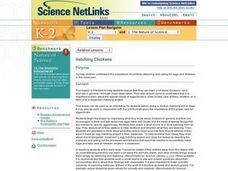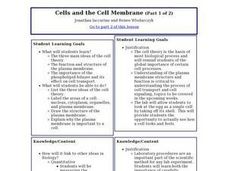Nuffield Foundation
Investigating Osmosis in Chickens' Eggs
You might not be able to learn through osmosis, but you sure can observe it! Scholars observe and measure osmosis using chicken eggs. They control for multiple variables to determine which variables have an impact and how the impact...
Curated OER
Hatching Chickens
Students consider the concept that much can be learned from the natural world by observation. They observe the incubation and hatching of chicken eggs in the classroom and discuss the needs of living things.
Curated OER
Hatching Chickens
Students understand the process of how an egg hatches. In this hatching eggs lesson, students care for eggs and chickens while the eggs are hatching. Students observe the hatching process and relate to other animals and humans.
Curated OER
The Birds of a Feather Flock Together
Fifth graders identify all parts of an egg, and explore their importance to the life cycle of a chicken. Learners compare all sorts of birds and place them in categories based on what they look like. This five-day lesson plan effectively...
Curated OER
Egg Words Crossword Puzzle
This crossword puzzle is all about eggs! Learners use the given clues to fill in the squares in the puzzle. Since this is an online interactive resource, immediate feedback is available; although it only tells you whether you are wrong...
LABScI
Cell Diffusion and Permeability: The See-Thru Egg Lab
Create a model to study a microscopic phenomenon. The seventh of 12 lessons uses an egg (without its shell) to represent a cell membrane. Using different solutions, learners explore the concept of cell diffusion. They monitor...
Curated OER
Hatching Chickens
Students observe and care for eggs and chickens. In this life cycles activity, students recall facts about chickens and how they hatch. Students read the article Hatching Eggs in the Classroom and observe the life cycle of the chicken in...
Curated OER
Inside the Egg, Hatching Chickens
Young scholars explore how an egg becomes fertilized. In this biology lesson, students "candle" a variety of eggs in order to determine which ones have been fertilized and which ones haven't. Student use paper plates to create a graphic...
Curated OER
Hatching Chickens
Students observe chicks hatching from eggs. In this science lesson, students view a video to develop an understanding of the proper care and needs of eggs and live animals. This is a great precursor activity for hatching eggs in class.
Curated OER
Crossword Puzzle: Chicken Incubation
For this chicken incubation crossword worksheet, students read 6 clues pertaining to the hatching and incubation of chicken eggs. Students place their answers in a crossword puzzle.
Curated OER
Egg Story Mini Book
In this egg mini book worksheet, students will color, cut out and collate pages to make a simple, picture mini book about the life cycle of a chicken.
Curated OER
Life Comes in Cycles
Kids are fascinated by chickens and their eggs. Here is a learning exercise has young learners take a look at the four stages in a chicken's life cycle. They have four cycles to organize: egg, chick, young bird, and adult. They have to...
Serendip
Introduction to Osmosis
A chicken egg is a very large cell—perfect for investigating osmosis! Scholars conduct an experiment with vinegar and eggs that helps them understand the process of osmosis. They follow the activity with an in-depth look at osmosis in...
Curated OER
Hatching chickens
Students recognize the need for gentle care of eggs. In this chicken hatching lesson, students observe the process of incubating eggs for hatching. Students find the materials needed to properly care for the chicks. Students complete a...
Curated OER
Parts of a Chicken
In this chicken anatomy worksheet, learners color and label 11 major parts of a chicken. There is a word bank to assist students.
Curated OER
Egg Parts
In this parts of an egg worksheet, students label a detailed diagram with 8 parts of an egg. There is a word bank of words but no information given here.
Curated OER
Life Cycle of Animals: Chicken, Duck, Frog
For this animal life cycles worksheet, students complete a ten question true/false assessment pertaining to life cycles of the frog, duck, or chicken. Students draw the life cycle of each animal in a separate box.
Curated OER
The Egg Activity
Students comprehend the three basic steps of science: 1) Observation, 2) Statements of cause and effect (Hypotheses), and 3) Testing. By working with an egg, students are required to observe an object that is very common to them. This...
Curated OER
Hatching Chickens
Students learn the importance of caring for eggs as they hatch chickens. In this egg hatching lesson, students observe what happens when eggs are hatched into chickens by completing a e-worksheet and watching a web based movie.
Curated OER
Cells and the Cell Membrane
Pupils investigate the properties of cell membranes by isolating the membrane surrounding chicken eggs. They set up an experiment by placing eggs in a vinegar solution for three days. A powerpoint lecture emphasizes the structure of the...
Curated OER
Where Does Food Come From?
Students recognize that food we eat comes from farms. In this where does food come from lesson, students discuss planting crops and how they grow. Students plant seeds for edible crops and eat them when are ripe. Students sing a song...
Curated OER
How do Hypotonic, Hypertonic, and Isotonic Solutions Affect the Water Movement of a Cell?
After removing the shell from a raw egg, cell biologists soak the egg in either a hypotonic, hypertonic, or isotonic corn syrup solution. They calculate the percent change in mass and compare it to the strength of the solution in a...
Curated OER
Math in Science-Knowing the Calories You Take In!
I can burn off one scrambled egg in 30 minutes of walking? Explain how we daily consume and burn calories using this fun worksheet, which breaks down basic foods and activities into kilocalorie equivalents. Nutritionists calculate the...
Curated OER
What's Hatching in Kindergarten?
Students identify oviparous animals. They brainstorm a list of animals that lay eggs, read "Chickens Aren't The Only Ones" by Ruth Heller and then add to the list. Students complete a booklet that shows an egg and an oviparous animal.
Other popular searches
- Chicken Eggs in Vinegar
- Hatching Chicken Eggs
- Hatch Chicken Eggs
- Fertilized Chicken Eggs
- Incubation of Chicken Eggs
- Candling Chicken Eggs
- Chicken Eggs Calendar
- Chicken Eggs Hatched
- Counting Chicken Eggs
- Eggs/chicken

























